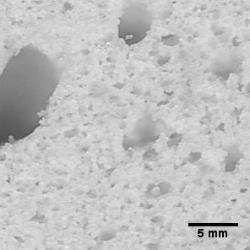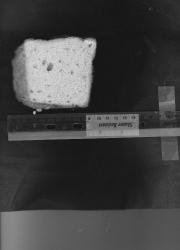Magnification
Reply |
Threaded

Open this post in threaded view
|
More ♦
♦
| Loading... |
| Reply to author |
| Edit post |
| Move post |
| Delete this post |
| Delete this post and replies |
| Change post date |
| Print post |
| Permalink |
| Raw mail |
Magnification
|
How do I know what magnification do I have?
I scanned my picture, the whole image size is 2464x3432 pixels. I cropped it to remove excess background to 1260x1260 pixels. Then I selected a 296x296 pixels and duplicate that to open in a separate window. I need to know the magnification of that window. Does anybody know how to measure it? Thanks! |
Reply |
Threaded

Open this post in threaded view
|
More ♦
♦
| Loading... |
| Reply to author |
| Edit post |
| Move post |
| Delete this post |
| Delete this post and replies |
| Change post date |
| Print post |
| Permalink |
| Raw mail |
Re: Magnification
|
Scan a ruler at the same resolution and calculate the pixel size in the
corresponding units. Since you didn't scale the image, but just cropped it the pixel size will be the same in all three images. 2013/3/25 esther31 <[hidden email]> > How do I know what magnification do I have? > I scanned my picture, the whole image size is 2464x3432 pixels. I cropped > it > to remove excess background to 1260x1260 pixels. Then I selected a 296x296 > pixels and duplicate that to open in a separate window. > > I need to know the magnification of that window. Does anybody know how to > measure it? > > Thanks! > > > > -- > View this message in context: > http://imagej.1557.n6.nabble.com/Magnification-tp5002384.html > Sent from the ImageJ mailing list archive at Nabble.com. > > -- > ImageJ mailing list: http://imagej.nih.gov/ij/list.html > ... [show rest of quote] -- Dr. Stoyan P. Pavlov, MD, PhD Departament of Anatomy, Histology and Embryology Medical University "Prof. Dr. Paraskev Stoyanov", Varna Prof. Marin Drinov Str.55 9002 Varna Bulgaria Tel: +359 (0) 52 - 677 - 086 e-mail: [hidden email] -- ImageJ mailing list: http://imagej.nih.gov/ij/list.html |
Reply |
Threaded

Open this post in threaded view
|
More ♦
♦
| Loading... |
| Reply to author |
| Edit post |
| Move post |
| Delete this post |
| Delete this post and replies |
| Change post date |
| Print post |
| Permalink |
| Raw mail |
Re: Magnification
|
In reply to this post by esther31
Now, the simple answer.
When you crop an image you do not change its magnification - if that is knowable - UNLESS you resize what is left. Changing the resolution will not change the 'magnification' UNLESS the size of the image is altered in the process. The final magnification of 'John' may be different but all changes to the image of 'John' are relative. John is not any bigger than he was when the image was captured, and unless you know the dimension of some object in the image that is left, the magnification will not be calculable. Processing of the type you have performed is usually applied to improve the image. If you still have the original image, you can determine the 'new magnification' by comparing the dimensions of corresponding objects in the original and final images. Cheers, again, Fred Frederick C. Monson, PhD Technical Director Center for Microanalysis and Imaging, Research and Training (CMIRT) West Chester University of Pennsylvania Schmucker Science South - Room SSS-024 MailDrop: Geology-Astronomy 750 South Church Street West Chester, PA, 19383 610-738-0437 [hidden email] HomePage: http://cmirt.wcupa.edu (with link to instrument Scheduler) -----Original Message----- From: ImageJ Interest Group [mailto:[hidden email]] On Behalf Of esther31 Sent: Monday, March 25, 2013 12:47 PM To: [hidden email] Subject: Magnification How do I know what magnification do I have? I scanned my picture, the whole image size is 2464x3432 pixels. I cropped it to remove excess background to 1260x1260 pixels. Then I selected a 296x296 pixels and duplicate that to open in a separate window. I need to know the magnification of that window. Does anybody know how to measure it? Thanks! -- View this message in context: http://imagej.1557.n6.nabble.com/Magnification-tp5002384.html Sent from the ImageJ mailing list archive at Nabble.com. -- ImageJ mailing list: http://imagej.nih.gov/ij/list.html -- ImageJ mailing list: http://imagej.nih.gov/ij/list.html |
Reply |
Threaded

Open this post in threaded view
|
More ♦
♦
| Loading... |
| Reply to author |
| Edit post |
| Move post |
| Delete this post |
| Delete this post and replies |
| Change post date |
| Print post |
| Permalink |
| Raw mail |
Re: Magnification
|
Im sorry. I am still confuse.
I was scanning a slice of cake So I know the size of the cake which is about 8 cm x 7 cm. I also have a ruler by the cake, which are both scanned. So I set my scale according to that ruler, and convert everything in mm... because I do not understand the concept of pixel. I have that ruler with the cake and then did all of the cropping and duplicate with it. Attached is my pictures. Now, I put my image with the scale bar on my thesis and my advisor wants me to state the magnification of that image. Thanks!  
|
Reply |
Threaded

Open this post in threaded view
|
More ♦
♦
| Loading... |
| Reply to author |
| Edit post |
| Move post |
| Delete this post |
| Delete this post and replies |
| Change post date |
| Print post |
| Permalink |
| Raw mail |
Re: Magnification
|
In reply to this post by fmonson
Here is my take on this:
Magnification means how much bigger or smaller the image is compared to the original object. That is OK if you only use a microscope, but gets confusing when you use images (i.e. how bigger/smaller will they be shown/printed?). As Stoyan suggested, scan a ruler and measure how big a pixel is (you can do a spatial calibration within IJ with the scan of the ruler). Because you rarely know at which size the image will eventually be shown or printed, the best approach (others might differ) is to either: a) add a calibration bar (there is a command for this) or b) just give the size in calibrated units of the width of the photo and report this in the legend (i.e. field width 54cm) The advantage of a) is that you do not have to remember this size and still have the bar if you choose to crop it or resize. The advantage of b) is that you do not change the pixels of the image by drawing the bar. I think that you can add the bar as an overlay, but not sure all programs might be able to show it. I always quote pixel size as well, because in images given in calibrated units, you can't easily tell the resolution (amount of detail) of the image. But that is a different story. Hope it helps Gabriel -- ImageJ mailing list: http://imagej.nih.gov/ij/list.html |
Reply |
Threaded

Open this post in threaded view
|
More ♦
♦
| Loading... |
| Reply to author |
| Edit post |
| Move post |
| Delete this post |
| Delete this post and replies |
| Change post date |
| Print post |
| Permalink |
| Raw mail |
Re: Magnification
|
In reply to this post by esther31
I agree with the previous responses that your image with the black calibration bar should be sufficient, BUT to satisfy your advisor:
Print your image exactly the size it will appear in your printed thesis. Measure the black bar. If it is 20 mm on the printed image, then magnification is 20/5 = 4 X. You might add to the caption, "Magnification is 4X on the printed thesis page." Then delete the sentence before you submit your thesis for publication elsewhere. -----Original Message----- From: ImageJ Interest Group [mailto:[hidden email]] On Behalf Of esther31 Sent: Monday, March 25, 2013 2:26 PM To: [hidden email] Subject: Re: Magnification Im sorry. I am still confuse. I was scanning a slice of cake So I know the size of the cake which is about 8 cm x 7 cm. I also have a ruler by the cake, which are both scanned. So I set my scale according to that ruler, and convert everything in mm... because I do not understand the concept of pixel. I have that ruler with the cake and then did all of the cropping and duplicate with it. Attached is my pictures. Now, I put my image with the scale bar on my thesis and my advisor wants me to state the magnification of that image. Thanks! <http://imagej.1557.n6.nabble.com/file/n5002399/Regular_1_with_scale_bar.jpg> <http://imagej.1557.n6.nabble.com/file/n5002399/Regular_1.jpg> -- View this message in context: http://imagej.1557.n6.nabble.com/Magnification-tp5002384p5002399.html Sent from the ImageJ mailing list archive at Nabble.com. -- ImageJ mailing list: http://imagej.nih.gov/ij/list.html -- ImageJ mailing list: http://imagej.nih.gov/ij/list.html |
«
Return to ImageJ
|
1 view|%1 views
| Free forum by Nabble | Disable Popup Ads | Edit this page |

